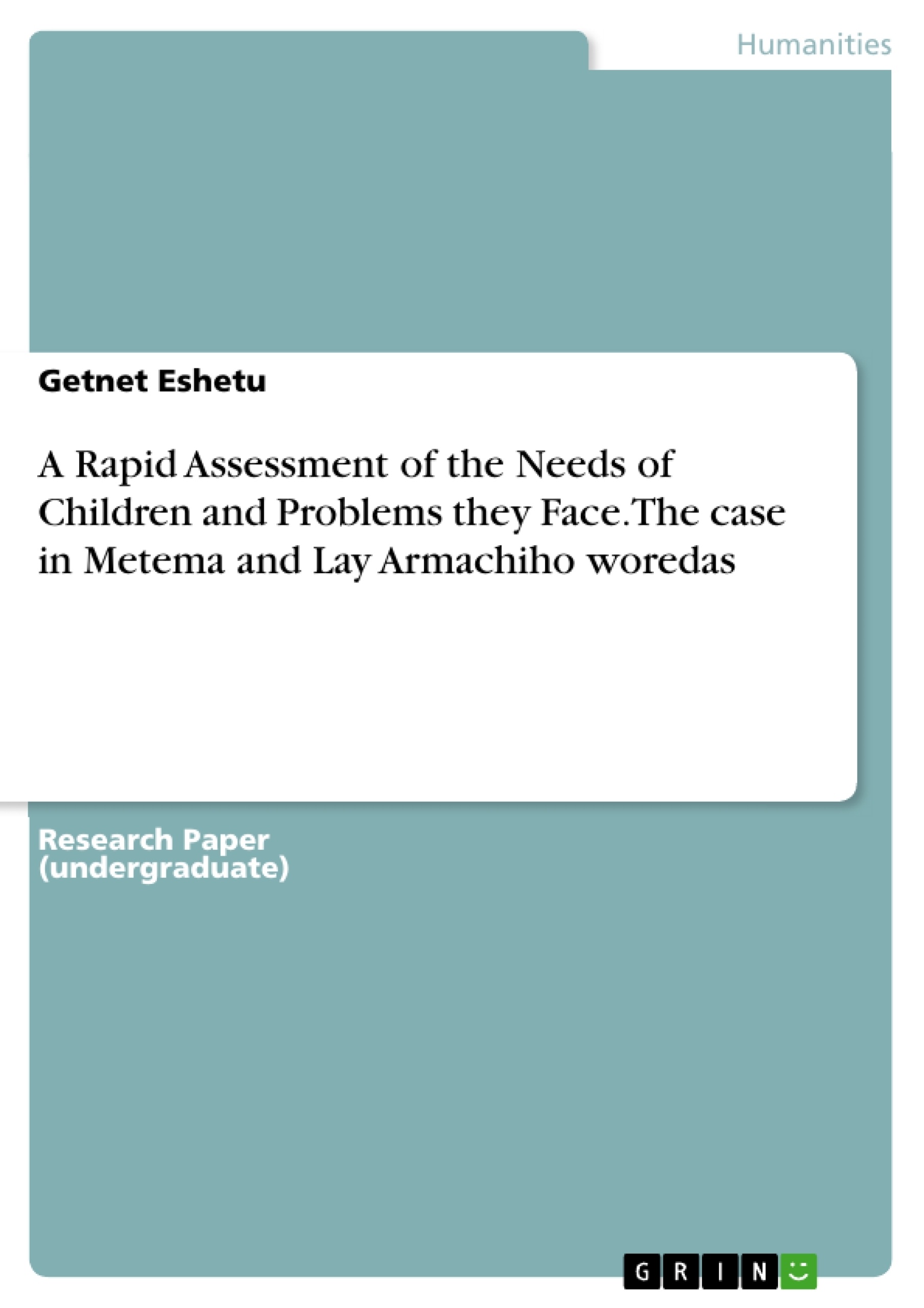The purpose of this short assessment is to determine the scale of the needs and protection risks for children affected by maltreatment. Furthermore, it is to determine the potential and actual capacities to respond to these within Metema and Lay Armachiho, woredas of the North Gondar Zone Amhara region in Ethiopia.
Although the analysis of the information collected from 95 interviews shows some prevention measures, it reveals the presence of child violence, abuse, neglect, and exploitation. In addition, it was identified that the situation is aggravated due to the presence of child trafficking in one woreda and child disability problems in the other woreda. Additionally, the presence of orphans, vulnerable children and harmful traditional practices are identified in both areas. Finally, the study recommends an update of old and installation of new measures to be taken against the mentioned abuse.
Inhaltsverzeichnis (Table of Contents)
- 1. Introduction
- 2. Background
- 3. Objectives
- 4. Methodology
- 5. Findings
- A. Child Maltreatment and Children's well-being
- B. Children with Disabilities
- C. Child Trafficking
- D. Orphan and Vulnerable Children (OVCs) and the situations of their families
- E. Harmful Traditional Practice (HTPs) and HIV/AIDS
Zielsetzung und Themenschwerpunkte (Objectives and Key Themes)
This rapid assessment aimed to evaluate the wellbeing and protection needs of children in Metema and Lay Armachiho woredas of North Gondar Zone in 2015. The study utilized interviews with community members and officials to gather data on various child-related issues.
- Child Maltreatment and its various forms
- The challenges faced by children with disabilities
- The prevalence and impact of child trafficking
- The circumstances of Orphaned and Vulnerable Children (OVCs) and their families
- Harmful Traditional Practices (HTPs) and their connection to HIV/AIDS
Zusammenfassung der Kapitel (Chapter Summaries)
1. Introduction: This chapter likely provides an overview of the study's context, including the geographic location, the population being studied, and a brief statement of the problem being addressed. It sets the stage for the subsequent sections by highlighting the importance of understanding child wellbeing and protection needs in the specified regions.
2. Background: This chapter probably delves into the socio-cultural context of the study area, potentially providing information on relevant historical factors, existing social structures, and prevalent customs that might influence child wellbeing and protection. It might also discuss prior research or initiatives concerning child welfare in the region, setting the current study within a broader context.
3. Objectives: This section clearly outlines the specific goals and research questions that guided the study. It likely details what the researchers hoped to achieve through the data collection and analysis, providing a roadmap for the subsequent chapters.
4. Methodology: This chapter describes the research methods employed in the assessment. It would explain the data collection techniques used (e.g., interviews, surveys), the target population, the sample size, and the data analysis procedures followed. The chapter would justify the chosen methodologies and address potential limitations.
5. Findings: This chapter presents the key findings of the assessment, organized into subsections addressing different aspects of child wellbeing and protection. Each subsection likely presents data on a specific issue (e.g., child maltreatment, disability, trafficking), providing a detailed account of the observations and results.
Schlüsselwörter (Keywords)
Child wellbeing, child protection, rapid assessment, Ethiopia, North Gondar Zone, child maltreatment, child trafficking, orphaned and vulnerable children (OVCs), harmful traditional practices (HTPs), HIV/AIDS, children with disabilities, community-based interventions.
Frequently Asked Questions: Rapid Assessment of Child Wellbeing and Protection Needs in North Gondar, Ethiopia
What is the main topic of this document?
This document provides a comprehensive preview of a rapid assessment report evaluating the wellbeing and protection needs of children in Metema and Lay Armachiho woredas of North Gondar Zone, Ethiopia in 2015. It includes the table of contents, objectives, key themes, chapter summaries, and keywords.
What are the key themes explored in the assessment?
The assessment focuses on several key themes related to child wellbeing and protection, including: child maltreatment (various forms), challenges faced by children with disabilities, the prevalence and impact of child trafficking, the circumstances of orphaned and vulnerable children (OVCs) and their families, and the relationship between harmful traditional practices (HTPs) and HIV/AIDS.
What methodology was used in the assessment?
The assessment utilized interviews with community members and officials to gather data on various child-related issues. The specific details of the methodology (sample size, data analysis techniques, etc.) are detailed in Chapter 4 of the full report.
What are the key findings of the assessment (summarized)?
The key findings are presented in Chapter 5, organized by theme. Each section details data related to a specific issue (child maltreatment, disability, trafficking, OVCs, HTPs and HIV/AIDS).
What is the geographic focus of the assessment?
The assessment focuses on the Metema and Lay Armachiho woredas of the North Gondar Zone in Ethiopia.
What is the time period covered by the assessment?
The assessment was conducted in 2015.
What are the objectives of the study?
The primary objective was to evaluate the wellbeing and protection needs of children in the specified region. Specific research questions guiding the study are outlined in Chapter 3.
What types of data were collected?
Data were collected through interviews with community members and officials.
What are the key words associated with this assessment?
Key words include: Child wellbeing, child protection, rapid assessment, Ethiopia, North Gondar Zone, child maltreatment, child trafficking, orphaned and vulnerable children (OVCs), harmful traditional practices (HTPs), HIV/AIDS, children with disabilities, community-based interventions.
Where can I find the full report?
The provided text is a preview. The full report would need to be obtained from the publishing company.
- Quote paper
- Getnet Eshetu (Author), 2015, A Rapid Assessment of the Needs of Children and Problems they Face. The case in Metema and Lay Armachiho woredas, Munich, GRIN Verlag, https://www.grin.com/document/333988



